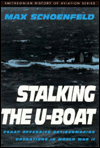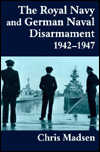Stalking the U-boat
USAAF Offensive Antisubmarine Operations in World War II
Schoenfeld, Maxwell Philip
1995, Smithsonian Institution Press, Washington
ISBN 1560984031
231 pages, 23 photos, 4 maps
| Type. | Unit/operational history |
| Pros. | Only book on its subject; well-researched; informed analysis |
| Cons. | Some fates now outdated |
| Rating. |  |
 This book covers the operations of the 479th and 480th Groups of the US Army Air Forces Antisubmarine Command in the eastern Atlantic during 1942-43, including operations in the Bay of Biscay and off the North African coast. Given the short span during which these units operated, the author is able to set forth what amounts to a complete unit history of these never-before-studied groups, interwoven with descriptions of state of the art in technologies and current tactics, all within the confines of a relatively short but very well-organized and informative book. Using official records, first-person accounts, and documents preserved by members of the groups, the author puts together a very complete picture of their activities and experiences during their brief period of deployment.
This book covers the operations of the 479th and 480th Groups of the US Army Air Forces Antisubmarine Command in the eastern Atlantic during 1942-43, including operations in the Bay of Biscay and off the North African coast. Given the short span during which these units operated, the author is able to set forth what amounts to a complete unit history of these never-before-studied groups, interwoven with descriptions of state of the art in technologies and current tactics, all within the confines of a relatively short but very well-organized and informative book. Using official records, first-person accounts, and documents preserved by members of the groups, the author puts together a very complete picture of their activities and experiences during their brief period of deployment.
In addition to comprehensive coverage of weapons, technologies, and operational and training problems which challenged the units, the book analyzes sightings and attacks, successes, failures, and changing tactics and strategies on both sides. Numerous tables provide statistical analysis of sightings, attacks and their results, and losses of both U-boats and aircraft. The U-boats' side of the story is not neglected; whether or not the U-boat returned fire, its actions during the attack, the fates of the crew of sunken boats, and the highlights of the operational histories of U-boats sunk are all present in these pages.
Every attack on a U-boat by these groups is described. The main achievements of each operational period, and and the effectiveness of weapons and tactics used, are analyzed. The author also examines battles between aircraft of these groups and the Luftwaffe, and some friendly fire incidents.
Two strong themes within the book are the ineffectiveness of Doenitz' Fight Back order as a strategy for keeping U-boats alive, and the transformation of thinking about the use of aircraft against U-boats - from defense of convoys, to an offensive strategy of hunting down the submarines.
Books in certain fields have a tendency to become outdated as soon as they are written, and this applies to the study of U-boats, where long-standing fates are constantly being revised as new information becomes available. This is true for this book, and somewhat limits its use as a reference resource. In some cases the number of the boat under attack is not given; in other cases, the number given turns out to be wrong, based on later analysis. In some cases a sinking is attributed to a specific aircraft, while comparison with more current sources shows that the fate is listed as unknown or as resulting from a different aircraft or a different cause entirely. However, this issue is outweighed by the value to be found in detailed accounts of the attacks and sinkings on specific boats which are correct, and by the knowledge to be gained of attack strategies, the details to be garnered from personal accounts, and the interesting glimpses into the minutiae of daily life in the aircraft (including the somewhat bizarre practice of using carrier pigeons released from aircraft as messengers). Furthermore, information on the U-boats themselves (commander, crew, launch date, etc.) is generally faultless. Includes 9 appendices.
Review written by Tonya Allen.
Published on 30 Jan 2003.
This title is highly recommended.
Purchase information: (info) Get Stalking the U-boat now at amazon.com ($ 38.98)
Get Stalking the U-boat now at amazon.com ($ 38.98) Get Stalking the U-boat now at amazon.co.uk
Get Stalking the U-boat now at amazon.co.uk
Return to our main review page.



